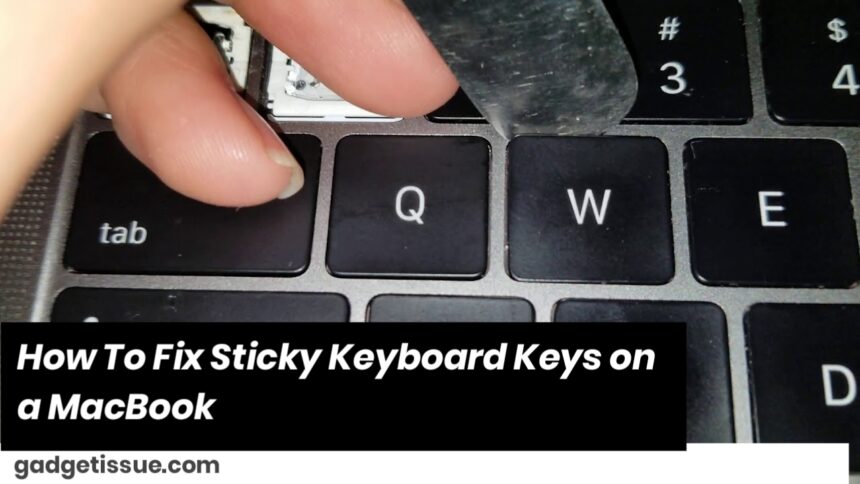Sticky keys on a MacBook can be frustrating, especially if you frequently type or use shortcuts. The issue can occur due to dirt, dust, or debris getting lodged under the keys, or simply due to wear and tear over time. Here’s a guide to help you fix sticky keyboard keys on your MacBook.
1. Shut Down Your MacBook
- Safety First: Before attempting any cleaning or maintenance on your MacBook, turn it off completely. Unplug any cables and disconnect peripherals to avoid any damage.
2. Clean the Keyboard with Compressed Air
- Use Compressed Air: The easiest way to remove dirt or dust from your MacBook keyboard is by using compressed air. Hold your MacBook upside down at a 75-degree angle and gently spray air around the sticky keys. This will help dislodge any debris trapped under the keys.
- Spray in Short Bursts: Be careful not to spray too much air at once. Short bursts of air are more effective and safer for your MacBook.
3. Clean the Sticky Keys with a Microfiber Cloth

- Dampen a Microfiber Cloth: Lightly dampen a microfiber cloth with water or a screen-safe cleaning solution (make sure it’s not dripping wet). Gently wipe the surface of the keys, paying special attention to the sticky key.
- Avoid Excess Moisture: Do not use too much liquid, as it can seep into the keyboard and damage the internal components.
4. Remove the Keycap (Optional)
- Pop Off the Key: If the key remains sticky after cleaning the surface, you can try removing the keycap to clean underneath it. Use a flat tool (like a plastic spudger) to gently pry off the keycap. Be careful not to break any clips.
- Clean Underneath: Once the keycap is removed, you can use compressed air or a small brush to clean underneath the key. Wipe the area with a dry microfiber cloth to remove any remaining dirt or dust.
- Reattach the Keycap: After cleaning, carefully snap the keycap back into place. Gently press down on the key until you hear it click back into its position.
5. Use Isopropyl Alcohol for Sticky Residue
- Clean Sticky Residue: If sticky residue (such as food or drink spills) is causing the keys to stick, you can use a small amount of isopropyl alcohol (70% or higher) on a cloth or cotton swab to clean the affected area. Be sure to apply alcohol only to the cloth, not directly to the keyboard.
- Wipe Down: Gently clean around the edges of the key and the surrounding areas to remove any gunk. Isopropyl alcohol dries quickly, so it won’t damage your MacBook’s internal components.
6. Check for Software Issues
- Restart Your MacBook: Sometimes, a sticky key issue can be related to a software glitch. Restart your MacBook to see if the issue resolves itself.
- Check Keyboard Settings: Go to System Preferences > Keyboard and check if any settings, such as “Key Repeat” or “Sticky Keys,” are causing the issue. Adjust the settings if necessary.
7. Reset the SMC and NVRAM
- Reset the SMC: If the issue persists, resetting the System Management Controller (SMC) can sometimes fix keyboard problems. To do this:
- Shut down your MacBook.
- Press and hold Shift + Control + Option (on the left side of your keyboard) and the Power button for 10 seconds.
- Release all keys, then press the Power button again to turn your MacBook back on.
- Reset NVRAM: Resetting the NVRAM can also help resolve keyboard issues. To reset it:
- Shut down your MacBook.
- Turn it on and immediately press and hold Option + Command + P + R.
- Keep holding the keys for about 20 seconds, then release and let the MacBook boot up normally.
8. Consider Using a Keyboard Cover
- Protect the Keys: If dust and debris are frequently causing sticky keys, consider using a keyboard cover. These thin silicone covers can protect your MacBook’s keyboard from dirt, dust, and liquids. However, be sure to remove it when typing for extended periods to prevent heat buildup.
9. Visit an Authorized Service Provider
- If the Issue Persists: If cleaning doesn’t fix the issue, and the sticky key remains a problem, the problem may be mechanical, and professional repair might be necessary. Contact an Apple Authorized Service Provider or visit an Apple Store to have the keyboard checked or replaced.
10. Prevent Future Issues
- Keep Your MacBook Clean: Regularly clean your MacBook’s keyboard with compressed air and a microfiber cloth to prevent dirt from building up.
- Avoid Eating or Drinking Near the Keyboard: Try not to eat or drink near your MacBook to prevent spills or crumbs from causing sticky keys.
Conclusion:
Sticky keyboard keys on a MacBook can be easily fixed with a few simple steps, including cleaning the keys, removing debris, and checking for software issues. However, if the problem is more severe, it may require professional help. Regular maintenance and care can help prevent future issues and keep your MacBook’s keyboard in good working condition.
Also Read : Apple Resolves Critical Zero-Day Vulnerability Affecting All Devices with Latest Update







